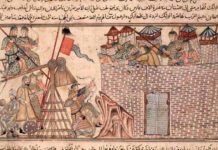The Indonesian archipelago consists of more than 13,500 islands and some 300 ethnic groups. With this great diversity and the difficulty in communications across waters plagued with storms and pirates, it has always been difficult to establish a state that extend across more than one island. Srivijaya was one of the first important states to be based in the Indonesian archipelago.
The basis of Srivijaya was almost wholly that of maritime trade. Since the beginning of recorded history, trade vessels had passed to and from China to Europe, India and Arabia. Since ships were unable to sail that distance without stopping – as indeed they are still unable to do – and because it was advantageous to stop at various ports to conduct diplomacy and to participate in smaller-scale local trade markets. The prevailing trade winds around the Indonesian archipelago meant that it was necessary for ships to remain at port for several months at a time at certain times of the year. There was also the danger of pirates, as well as storms and shipwreck in dangerous waters and the more common perils of life at the sea.
For these reasons, various ports in strategically located Indonesian islands developed as homes for skilled navigators, pilots – and pirates – and also became increasingly active in promoting intra-island and more long-distance trade. Infighting among the island states eventually produced a powerful multi-island state with a capital at Palembang and it is this state that we know as Srivijaya. Although most Southeast Asian history is notoriously difficult to investigate owing to the general lack of records and documentation and the low level of development of archaeological excavations, we have assistance in the case of Srivijaya through the presence of some monuments which describe the feats and achievements of kings and princes, as well as the record of the visit of the Chinese monk I Ching, among others.
Combining these sources, a picture of Srivijaya is revealed of a Buddhist society with a high degree of learning of Sanskrit – the ancient Indian language that is so important in understanding ancient Buddhist texts. Indeed, I Ching recoomends that students wishing to learn Sanskrit should base themselves in Srivijaya. Both Hinayana and Mahayana forms of Buddhism were observed and these were also mixed with Hinduistic elements, which probably arrived directly from India. This formed a style that, in combination with architectural and social elements, has come to be known as Javanese. This included the syncretic style of the religion – which means that it combined elements from different religious traditions and found ways of overcoming the apparent contradictions between them. The later Islamisation of Indonesia has led to a lack of awareness of this heritage, although the ethnic diversity of the islands means that Bali, for example, remains a Hindu society, while other islands have significant Christian minorities whose origins date from later times.
From the C6th-7th CE, Srivijaya began to enforce its will upon neighbouring societies and, over the next three centuries, the boundaries of the state’s influence extended as far as the Malay peninsula as far north as the Kra Isthmus (now southern Thailand), Borneo, Sumatra and Java. The state seems to have been a thalassocracy, which means it obtained its legitimacy – its ability to rule – and its power from its control of the seas and the rivers. It is likely, therefore, that this power did not extend far away from the water. Consequently, it would have been quite easy for people who did not wish to have been part of the state to have escaped a few miles inland, although island life away from Srivijayan civilization would have been dangerous and probably impoverished.
In around 1080, a vassal of Srivijaya, known as Jambi and better known subsequently as Melayu, overwhelmed its master militarily and became the leading power in the islands for the next two hundred years. After the archipelago region was largely converted to Islam, its earlier history has largely been forgotten, if not suppressed and few local scholars are interested in digging this far back into the past. Yet it would be well to remember that this huge sprawling country, which in modern years has in the western world attracted very little positive comment or publicity, has a fascinating history as an important cultural and economic power.
References
- Brown, Colin, A Short History of Indonesia: The Unlikely Nation? (Chiang Mai: Silkworm Books, 2003).
- Hall, D.G.E., A History of South-East Asia, fourth edition (Basingstoke: MacMillan Press Ltd., 1994).








